

Whether a product is successful at the point of sale or not depends on many different factors. One of the most crucial criteria here is undoubtedly the packaging. The look and feel of a beverage bottle influence a person’s decision to buy for many reasons.
Firstly, the container should be user friendly: particularly light and unbreakable like a PET bottle, for instance. Secondly, it should be sustainable – that is, recyclable – in order to satisfy consumers’ growing environmental awareness. Thirdly, it should fit in with the brand image and create an impression of high quality, also in order that the required price can be charged. Lastly, it should attract buyers’ attention so that it stands out from the range of products offered by the competition.
In order to meet these demands, the manufacturers of filling and packaging machines must offer beverage producers innovative concepts. The KHS Group has caught the latter’s attention here with its successful realization of Direct Print Powered by KHSTM. This is a direct printing system for PET containers using low-migration, LED UV-cured inks for food-safe bottle decoration.
The lack of label alone makes bottles dressed in this manner stand out from the crowd. The costs saved in procurement and warehousing logistics and the omission of label waste and adhesive also immediately speak for the direct print process. The greatest bene fits of this technology really become evident when we look at the bottle design, however. One hurdle for companies who tend to shy away from disruptive technology, however, is the relatively high cost of investment.
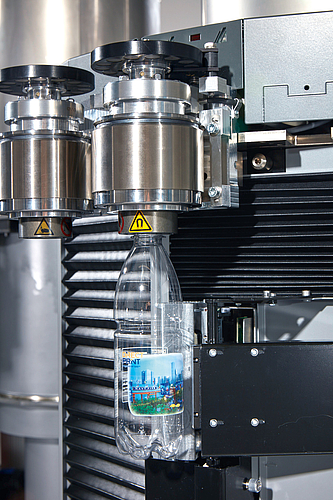
TECHNOLOGY IN DETAIL
When designing and producing small batches down to a quantity of one manufacturer are now much more flexible. It does not matter to the machine whether it prints one, two or 1,000 containers with different designs. This makes it possible to use individual motifs which are adapted and produced for marketing campaigns or even at the customer’s specific request.
The printing process and prepress stage now lie in the hands of the bottler. The container is printed prior to filling which makes integrating the system into existing lines rather demanding due to the space available. KHS provides the necessary software, which enables all motifs to be adjusted to the required bottle shape, as a web application. This can even be used by operators with little experience in color management or with print templates. The required templates are checked online and the ink requirement, bottle shape and other production data automatically calculated and coordinated. All information is finally provided together with a printable image file directly for the user through the control system on the customer’s machine.
It goes without saying for KHS that on no account must the print quality be inferior to that of a label. As the size of the droplets varies, the inkjet technology achieves an optical resolution of 1080 x 1080 dpi (physically 360 x 360 dpi) and works with both RGB and CMYK color models. The motif may be up to 70 mm high and the cylindrical containers can have a height of between 100 and 320 mm and a diameter of 40 to 115 mm. The print quality is retained both during further processing of the PET bottles on the line and during retail and later handling by the consumer.

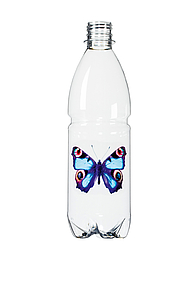
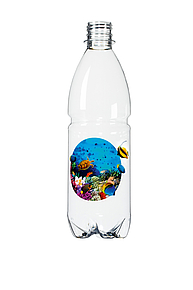
MANY DIFFERENT APPLICATIONS
New decoration options, such as the no-label look on transparent PET containers or the creation of individual bottles, are of great strategic interest to beverage producers. The great reduction in the time taken from the initial design idea to the finished bottle – brought about by the omission of the label design, order and delivery alone – is readily welcomed by marketing and advertising experts in particular. Totally new marketing ideas are also possible. The previous day’s football results printed on a beer bottle, soda pop bottles sporting the likenesses of the birthday girl or boy and his or her party guests or the winning numbers in a lottery: all of these ideas are now feasible. The smaller the number and the more individual the design of the containers produced, the more worthwhile the use of the direct print system. For very large batches the label remains the more economical option yet this is not the focus of marketing and advertising campaigns.
OPTIMUM COORDINATION OF PRINT AND BOTTLE SHAPE
In order that not only the print design but also the PET bottle itself satis es high demands when it comes to attracting buyers’ attention, sustainability and user friendliness, KHS develops the individual PET containers together with beverage producers. This includes holistic consultancy from the design through the technical engineering to the production of the PET bottle. The aim of Bottles & ShapesTM is to produce bottles with a high level of brand recognition which clearly stand out from those of the competition, bottles which can be produced cost effectively through lightweighting and which have a high degree of consumer affinity. Our KHS designers totally redesign the bottles according to the customer’s specific criteria. The future of this technology is promising as other types of packaging are also conceivable. Printing on cans, for example, has to date been primarily restricted by the high line speed of over 100,000 cans per hour. However, the capacity of the KHS printing machine concept is modular and can today be expanded well beyond the familiar output limit of 36,000 items per hour, meaning that can printing is also imaginable for the future. This produces a special primary packaging which is perfectly tailored to market requirements.
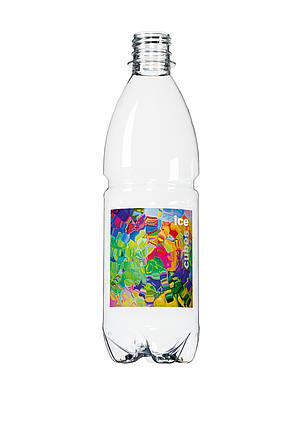
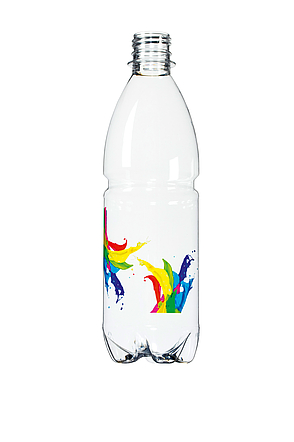
The comPETence center provides your organisation with a dynamic, cost effective way to promote your products and services.

magazine
Find our premium articles, interviews, reports and more
in 3 issues in 2025.


